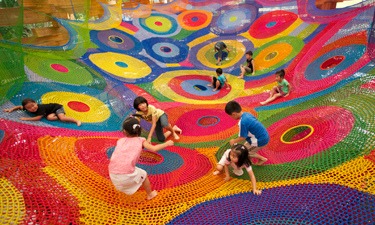 Worldwide, playgrounds are helping to define the rich cultures and social makeup of the places they inhabit…and beyond.
Worldwide, playgrounds are helping to define the rich cultures and social makeup of the places they inhabit…and beyond.
Here are some unique examples of playgrounds outside the U.S. that are inspiring children and invoking connections—from neighborhood, to national, and even to “not of this world.”
A National Memorial
Diana, Princess of Wales’ Memorial Playground
Kensington Gardens Park, London, ENGLAND
Opened in 2000 as a memorial to the late Princess Diana, this £1.7 million playground is located in the northwest section of Kensington Gardens Park—one of London’s eight “Royal Parks.” The playground is within sight of Kensington Palace, the former residence of the playground’s namesake.
More than 750,000 children use this free playground each year, which offers six play areas, including a large, climbable, wooden pirate ship; teepees; swings; slides; and a play beach. Within an area designed specifically for children with disabilities, fragrant plants and sound features help create a sensory experience.
The current playground, inspired by Peter Pan, was expanded over the site of a former playground founded by J.M. Barrie, the creator of the famous fictional children’s character. On the opposite end of Kensington Gardens stands a bronze Peter Pan statue by George Frampton, installed secretly by Barrie in 1912. Barrie maintained that the site was Peter’s landing point in Peter Pan in Kensington Gardens.
According to The Royal Parks, the playground design “seeks to provide for the physical, creative, social, and educational development of…children” and encourages them to “explore and follow their imaginations, learning whilst they play.”
Big Backyard
St. Kilda Adventure Playground
City of Port Phillip, Victoria, AUSTRALIA
The City of Port Phillip originally created this government-supported (Department of Families, Housing, Community Services, and Indigenous Affairs) playground in 1981 for children residing in high-rise public housing in the diverse St. Kilda area outside Melbourne. One of only five “Adventure Playgrounds” in the country, the colorful space was designed to create the feel of a big neighborhood backyard where, according to the city, disadvantaged children can “use their imagination and engage in “risk-taking” play in a safe, staffed environment.
Children have access to a range of amenities, including an airplane structure, a wooden horse with saddle, trampolines, a go-kart path, a chook house (hen house), a flying fox, a cubby house, a pirate ship, a wooden castle, swings and slides, a half-pipe, and a basketball court.
Citing the United Nations Declaration of Rights of the Child (Article 34) on their website, the city maintains that it “seeks to ensure that children growing up in the modern world still have the opportunity to play together whatever their backgrounds or circumstances.”
Spatial Wonder
BUGA 05 Playground
Riemer Park, Messestadt (Fair City) Riem, Munich, GERMANY
Munich installed this visually stunning senkärten (sunken garden) playground space, designed and created by Munich-based Rainer Schmidt Landscape Architects + City Planners, as part of Germany’s biannual national garden festival (Bundesgartenschau/BUGA) in 2005. The space exists in Riemer Park in the newly established Messestadt (Fair City) Riem in the eastern part of the city—formerly the location of the Munich Riem airport.
The contours and contrasting colors of the playground, without the addition of traditional equipment, help stimulate free physical movement and play. The surfacing for the playground is a double-layer combination of modified shredded tire rubber (base layer) and poured-in-place EPDM rubber (top layer).
History = Play!
Tårnlegepladsen (Tower Playground)
Faelledparken, Copenhagen, DENMARK
A collaboration between the City of Copenhagen, GHB Landscape Architects, and MONSTRUM resulted in this eye-catching playground renovation launched in November 2011 as part of Copenhagen’s comprehensive renewal of Faelledparken (Central Park). The design is based on the silhouette of five iconic towers in Copenhagen: City Hall, Our Savior’s Church, Round Tower, Marble Church, and the Stock Exchange.
“The playground…motivates children to get acquainted with historical facts about the city’s towers in a fun and playful way,” quotes Copenhagen Technical and Environmental Administration spokesperson Mille Bonde, noting the “nooks and crannies, gold spires, figures, slides, and climbing routes” featured.
The Round Tower rises 18 feet high, with an interior ramp that winds 2.5 times around to a lookout platform with a small planetarium. Children can slide back down the tower or take the rope bridge to “City Hall.” The towers also provide gadgets such as binoculars and electronic games, secret passageways, and a working carillon (church bells).
Art Transformed
Art can sometimes take us to fantastical places—as experienced in these hand-knitted playgrounds by Japanese fiber artist Toshiko Horiuchi MacAdam. Horiuchi MacAdam, joint owner of Canada- and Japan-based Interplay Design and Manufacturing, Inc., has been creating versions of the colorful play and climbing structures since the 1970s.
Rainbow Nest at Children’s Valley
Takino Suzuran Hillside National Park, Sapporo, Japan
In collaboration with Hokkaido Development Agency, T.I.S. & Partners, and Takano Landscape Planning, Interplay completed the installation of “Rainbow Nest” in 2000 at Children’s Valley in Takino Suzuran Hillside National Park in Sapporo. Horiuchi MacAdam is credited with hand-crocheting 90 percent of the “AirPocket” piece—the largest of its kind to date—using a simple wooden hook.
The play structure is set in a concrete dome that is partially submerged into the hillside, creating a naturally organic environment and invoking an ethereal sense of mystery for children as they climb, swing, and jump.
Knitted Wonder Space II in the Woods of Net Pavilion
Hakone Open-Air Museum, Hakone, Kanagawa Prefecture, Japan
In 2009 at the Hakone Open-Air Museum, a hand-knitted AirPocket playground piece titled “Knitted Wonder Space II” was installed in honor of the museum’s 40th anniversary. Replacing a playground created by Horiuchi MacAdam in 1981, Knitted Wonder Space II is housed in the newly constructed “Woods of Net” Pavilion by Tokyo-based Tezuka Architects, a large wooden structure composed entirely of timber and utilizing methodologies derived from ancient wooden Japanese temples.
Amy Kapp is a freelance writer in Northern Virginia.
Destination Play
April 1, 2013, Feature, by Amy Kapp

